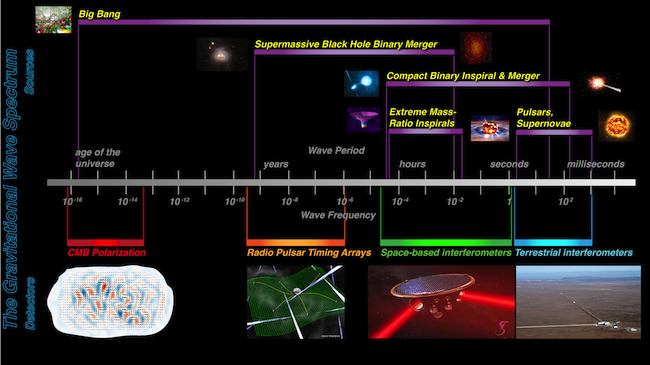LISA - the Laser Interferometer Space Antenna
The Laser Interferometer Space Antenna, or LISA for short, is a next-generation space observatory project proposed by the European Space Agency to observe gravitational waves in the frequency range of 0.0001 to 0.1 Hertz. Scientists from around the world hope to participate in this exciting mission.

Artist's impression of a Laser Interferometer Space Antenna (LISA) mission concept spacecraft. (Credit: AEI/Milde Marketing/Exozet)
Gravitational waves are "ripples in spacetime" caused by the rapid motion of compact massive objects, such as neutron stars and black holes. LISA will be most sensitive to large-scale events like galaxy mergers, black hole collisions, and neutron star binary systems. The mission consists of three separate spacecraft, which form the three corners of a large triangle in space. Each of the LISA spacecraft orbits the sun independently, trailing Earth's orbit by about 20 degrees. When a gravitational wave passes through, LISA would detect slight changes in the distances between the spacecraft using a measurement technique called laser interferometry. The project is expected to launch in the mid-2030s.
How do You Detect Gravitational Waves?
Laser interferometry enables LISA to detect tiny changes in distance. Here's how it works: laser beams from two spacecraft point toward a detector on another spacecraft, 1 million kilometers away. The laser beams precisely measure distances between the two spacecraft, creating two measurement arms. When the distance along the arms changes even slightly, the combined laser beams will show a series of light and dark fringes called an interference pattern. The interference pattern tells scientists that LISA has detected a gravitational wave. The two arms, formed by the three spacecraft, provide two detectors, which work together to confirm the observation and to get more details about the passing wave.
Why is LISA so big? It has to be big because gravitational waves stretch and squeeze spacetime iteself. For example, if there were two binary neutron stars spiraling into each other in the Virgo galaxy cluster, they would produce a wave no bigger than a thousandth the radius of a proton. The configuration proposed for LISA could measure a change in length of 10 to 100 times smaller than the diameter of an atom. To measure the very small changes expected for gravitational waves, the distance between spacecraft must be very large – about 1 million km. This is about two and a half times the distance between the Earth and the moon, which will make the observatory very sensitive!
On Earth, scientists can measure distances that are about 1 million times smaller than what LISA could do in space, in part because ground-based detectors can use much more powerful lasers. So, to get the same strain sensitivity, the length of an arm can be much smaller, about 4 km. The LIGO project has built two such detectors.
Together, LIGO and LISA cover different frequency ranges, and thus complement each other.

This chart shows the sources that are associated with each gravitational wave frequency range. It also shows the types of gravitational wave detectors required for different frequencies. Click image for a larger version. (Credit: NASA/J. I.Thorpe)
Ground-based detectors cannot see low frequencies because the ground moves too much (remember, these detectors can see motions that are smaller than atoms). A space-based detector, which is free from ground motion, is the only way to see those low frequencies. Other types of ground-based detectors use the Cosmic Microwave Background (CMB) or arrays of millisecond pulsars to detect gravitational waves. Space-based gravitational wave detectors will enable us to observe the range of frequencies where most of the known sources are located.
Expected Science Results
Once LISA starts to return data, scientists will compare the data to computer models to interpret what they see. Dr. Jeff Livas and his team of researchers at NASA are creating a "numerical laboratory" of models that represent gravitational wave phenomena. Using these waveform computer codes, scientists will be able to decipher LISA's message. They will be able to sift through the information, isolating sources of gravitational waves as well as the behaviors that cause them. The scientists behind the LISA mission hope to detect information about black holes and the big bang, how galaxies formed, as well as further, detailed proof of Einstein's famous theory of general relativity.
See what LISA could tell us about black holes, general relativity, and the big bang.
Published: August 2003
Text Reviewed: September 2018


